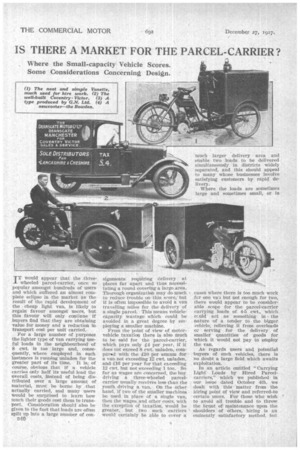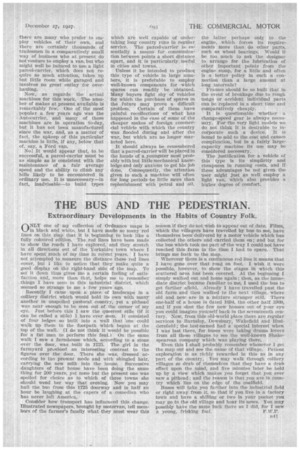IS THERE A MARKET FOR THE PARCEL-CARRIER?
Page 54

Page 55

If you've noticed an error in this article please click here to report it so we can fix it.
Where the Small-capacity Vehicle Scores. Some Considerations Concerning Design.
TT would appear that the three wheeled parcel-carrier, once so popular amongst hundreds of users and which suffered an almost complete eclipse in the market as the result of the rapid development of the Cheap light van, is likely to regain favour amongst users, but this favour will only continue if buyers find that they are obtaining value for money and a reduction in transport cost per unit carried.
For a large number of purposes the lighter type of van carrying useful loads in the neighbourhood of 8 cwt. is too large and, consequently, where employed in such instances is running unladen for the greater part of its time. It is, of course, obvious that• if a vehicle carries only half its useful load the overall costs, instead of being distributed over a large amount of material, must be borne by that actually carried, and many users would be surprised to learn how much their goods cost them to transport. Consideration should also be given to the fact that loads are often split up into a large number of con
n40
signments requiring delivery at places far apart and thus neeessitating a round covering a large area. Thorough organization may do much 1 to reduce trouble on this score,' but it is often impossible to avoid a van travelling miles for the delivery of a single parcel. This means vehiclecapacity wastage which could be avoided in a great degree by employing a smaller machine.
From the point of view of motorvehicle taxation there is also much to be Said for the parcel-carrier, which pays only £4 per year, if it does not exceed 8 cwt. unladen, cornparod with the 110 pet annum for a van not exceeding 12 cwt. unladen, and £16 per year for that exceeding 12 cwt. but not exceeding 1 ton. So far as wages are concerned, the boy driving a three-wheeled parcelcarrier usually receives less than the youth. driving a 'van. On the other hand, if two of the smaller machines be used in place of a single van, then the wages and other costs, with the exception of taxation, would be greater, but two such carrierS would certainly be able to cover a
much larger delivery area and enable two loads to be delivered simultaneously in districts widely separated, and this should appeal to many whose businesses involve satisfying customers by rapid delivery.
Where the loads are sometimes large and sometimes small, or in cases where there is too much work ler one vau but not enough for two,, there would appear to be considerable scope for the parcel-carrier carrying loads of 4-5 cwt., which cc.uld act . as something in • the nature of a tender to the bigger vehicle, relieving it from overloads or serving for the delivery of smaller quantities of goods for which it would not pay to employ the van.
As regards users and potential buyers of such vehicles, there is no doubt a large field which awaits exploitation.
In an article entitled "Carrying Light Loads by Hired Parcelcarriers," which we published in our issue dated October 4th, we dealt with this matter from the hiring point of view and referred-to certain users. For those who wish to avoid all trouble and to throw the brunt of maintenance upon the shoulders of others, hiring is an eminently satisfactory method, but
there are many who prefer to employ vehicles of their own, and there are certainly thousands, of tradesmen in a comparatively small way of business who at present do not venture to employ a van, but who might well be induced to use a light parcel-carrier. which does not require so much attention, takes up but little room while garaged and involves no great outlay for overhauling.
Now, as regards the actual machines for this work. The number of makes at present available is remarkably few. One of the most popular a few years ago was the Autoearrier, and Many of these machines are in operation to-day, but it ha e not been manufactured since the war, and, as a matter of fact, the upkeep of this particular machine is little, if any, below that of, say, a Ford van.
No It would appear that, to be successful, a parcel-carrier must be as simple as is consistent with the maintenance of a fair average speed and the ability to climb any hills likely to be encountered in ordinary use. It is tuutecessary—in fact, inadvisable—to build types which are well capable of undertaking long country rues in regular service.. The parcel-carrier is essentially a means for communication between points a short distance apart, and it is particularly useful in cities and towns.
Unless it be intended to produce this type of vehicle in large 111.11C17' hers, it is prefeeable to employ well-known components for which spares can readily be obtained. Many buyers fight shy of vehicles for which the purchase of spares in the future may prove a difficult problem. Certain of them have painful recollections of what has happened in the case of some of the cheaper makes of foreign commercial vehicle with which the country was flooded during and after the war, but which are no longer marketed here.
It should always be remembered that a parcel-carrier will be placed in the hands of a youngster most probably with but little mechanical knowledge and Only anxious to get his job done. Consequently, the attention given to stich a machine will often for long periods be little mere than replenishment with petrol and oil, the latter perhaps only to . the engine, which forces it requirements more than do other parts; such as wheel bearings. Would it be too much to ask the designer to arrange for the lubrication of other important points from the engine sump, for a little and often is a better policy in such a connection than a large amount at long intervals?
Frames should be so built that in the event of breakage due to rough usage or accident individual parts can be replaced in a short time and comparatively cheaply. .
It is questionable whether a change-speed gear is always necessary. For the very light models we • do not think it is desirable to incorporate such a device. It is bound to add to the cost and causes complication, but in a fairly largecapacity machine its use may be considered. necessary.
The justification for a vehicle of this 'type is its • simplicity and cheapness in . running costs, and if. these advantages be not given the user might just as well employ a light van; Which also provides a higher degree of comfort,


























































































